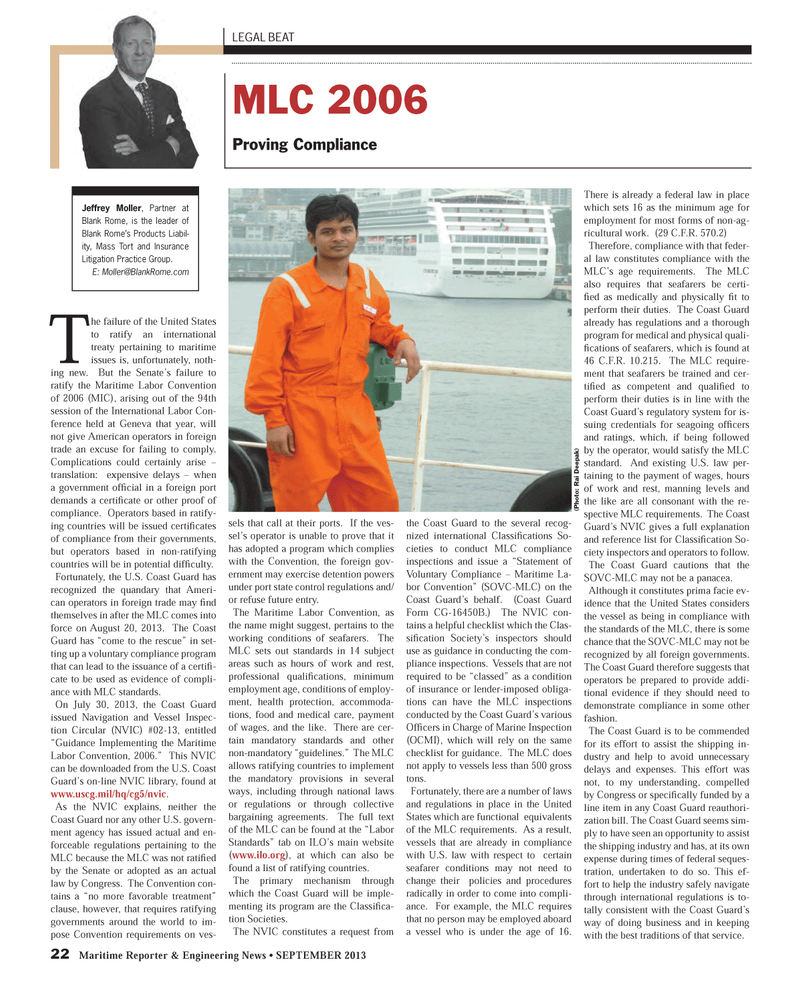
Page 22: of Maritime Reporter Magazine (September 2013)
Workboat Annual
Read this page in Pdf, Flash or Html5 edition of September 2013 Maritime Reporter Magazine
22 Maritime Reporter & Engineering News ? SEPTEMBER 2013 LEGAL BEAT MLC 2006Proving Compliance The failure of the United States to ratify an international treaty pertaining to maritime issues is, unfortunately, noth- ing new. But the Senate?s failure to ratify the Maritime Labor Convention of 2006 (MIC), arising out of the 94th session of the International Labor Con-ference held at Geneva that year, will not give American operators in foreign trade an excuse for failing to comply. Complications could certainly arise ? translation: expensive delays ? when a government ofÞ cial in a foreign port demands a certiÞ cate or other proof of compliance. Operators based in ratify-ing countries will be issued certiÞ cates of compliance from their governments, but operators based in non-ratifying countries will be in potential difÞ culty. Fortunately, the U.S. Coast Guard has recognized the quandary that Ameri- can operators in foreign trade may Þ nd themselves in after the MLC comes into force on August 20, 2013. The Coast Guard has ?come to the rescue? in set-ting up a voluntary compliance program that can lead to the issuance of a certiÞ -cate to be used as evidence of compli-ance with MLC standards. On July 30, 2013, the Coast Guard issued Navigation and Vessel Inspec- tion Circular (NVIC) #02-13, entitled ?Guidance Implementing the Maritime Labor Convention, 2006.? This NVIC can be downloaded from the U.S. Coast Guard?s on-line NVIC library, found at www.uscg.mil/hq/cg5/nvic . As the NVIC explains, neither the Coast Guard nor any other U.S. govern-ment agency has issued actual and en-forceable regulations pertaining to the MLC because the MLC was not ratiÞ ed by the Senate or adopted as an actual law by Congress. The Convention con- tains a ?no more favorable treatment? clause, however, that requires ratifying governments around the world to im-pose Convention requirements on ves-sels that call at their ports. If the ves-sel?s operator is unable to prove that it has adopted a program which complies with the Convention, the foreign gov-ernment may exercise detention powers under port state control regulations and/or refuse future entry. The Maritime Labor Convention, as the name might suggest, pertains to the working conditions of seafarers. The MLC sets out standards in 14 subject areas such as hours of work and rest, professional qualiÞ cations, minimum employment age, conditions of employ-ment, health protection, accommoda-tions, food and medical care, payment of wages, and the like. There are cer- tain mandatory standards and other non-mandatory ?guidelines.? The MLC allows ratifying countries to implement the mandatory provisions in several ways, including through national laws or regulations or through collective bargaining agreements. The full text of the MLC can be found at the ?Labor Standards? tab on ILO?s main website (www.ilo.org ), at which can also be found a list of ratifying countries.The primary mechanism through which the Coast Guard will be imple-menting its program are the ClassiÞ ca-tion Societies. The NVIC constitutes a request from the Coast Guard to the several recog-nized international ClassiÞ cations So- cieties to conduct MLC compliance inspections and issue a ?Statement of Voluntary Compliance ? Maritime La- bor Convention? (SOVC-MLC) on the Coast Guard?s behalf. (Coast Guard Form CG-16450B.) The NVIC con- tains a helpful checklist which the Clas-siÞ cation Society?s inspectors should use as guidance in conducting the com-pliance inspections. Vessels that are not required to be ?classed? as a condition of insurance or lender-imposed obliga- tions can have the MLC inspections conducted by the Coast Guard?s various OfÞ cers in Charge of Marine Inspection (OCMI), which will rely on the same checklist for guidance. The MLC does not apply to vessels less than 500 gross tons. Fortunately, there are a number of laws and regulations in place in the United States which are functional equivalents of the MLC requirements. As a result, vessels that are already in compliance with U.S. law with respect to certain seafarer conditions may not need to change their policies and procedures radically in order to come into compli-ance. For example, the MLC requires that no person may be employed aboard a vessel who is under the age of 16. There is already a federal law in place which sets 16 as the minimum age for employment for most forms of non-ag-ricultural work. (29 C.F.R. 570.2) Therefore, compliance with that feder- al law constitutes compliance with the MLC?s age requirements. The MLC also requires that seafarers be certi-Þ ed as medically and physically Þ t to perform their duties. The Coast Guard already has regulations and a thorough program for medical and physical quali-Þ cations of seafarers, which is found at 46 C.F.R. 10.215. The MLC require- ment that seafarers be trained and cer- tiÞ ed as competent and quali Þ ed to perform their duties is in line with the Coast Guard?s regulatory system for is- suing credentials for seagoing ofÞ cers and ratings, which, if being followed by the operator, would satisfy the MLC standard. And existing U.S. law per- taining to the payment of wages, hours of work and rest, manning levels and the like are all consonant with the re-spective MLC requirements. The Coast Guard?s NVIC gives a full explanation and reference list for ClassiÞ cation So- ciety inspectors and operators to follow. The Coast Guard cautions that the SOVC-MLC may not be a panacea. Although it constitutes prima facie ev-idence that the United States considers the vessel as being in compliance with the standards of the MLC, there is some chance that the SOVC-MLC may not be recognized by all foreign governments. The Coast Guard therefore suggests that operators be prepared to provide addi-tional evidence if they should need to demonstrate compliance in some other fashion. The Coast Guard is to be commended for its effort to assist the shipping in- dustry and help to avoid unnecessary delays and expenses. This effort was not, to my understanding, compelled by Congress or speciÞ cally funded by a line item in any Coast Guard reauthori-zation bill. The Coast Guard seems sim- ply to have seen an opportunity to assist the shipping industry and has, at its own expense during times of federal seques-tration, undertaken to do so. This ef- fort to help the industry safely navigate through international regulations is to-tally consistent with the Coast Guard?s way of doing business and in keeping with the best traditions of that service. Jeffrey Moller , Partner at Blank Rome, is the leader of Blank Rome?s Products Liabil- ity, Mass Tort and Insurance Litigation Practice Group. E: [email protected](Photo: Rai Deepak)MR #9 (18-25).indd 22MR #9 (18-25).indd 229/4/2013 3:41:38 PM9/4/2013 3:41:38 PM

 21
21

 23
23
